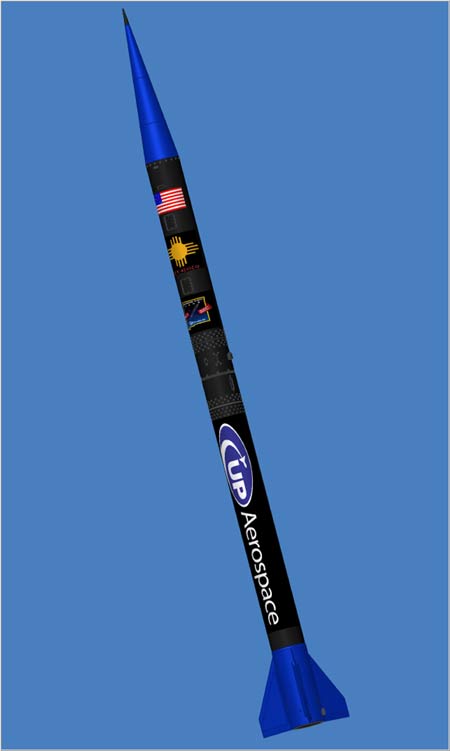Back To Back Rocket Shots Set For New Mexico Spaceport

BOULDER, Colorado -- Business is on the upswing for UP Aerospace--a firm that is offering suborbital rocket shots of experimental payloads out of the Southwest Regional Spaceport site in New Mexico.
In an update, the firm stated over the weekend that the first launch of their SpaceLoft XL--the inaugural flight from New Mexico's spaceport--has now been moved from August into early September.
A trio of rocket flights are on the UP Aerospace launch calendar (SL-1, SL-2, and SL-3). SL-1 has shifted to the first part of September, SL-2 as soon as a week later, with SL-3 roaring skyward in conjunction with the X Prize Cup festivities October 19-22 in neighboring Las Cruces.
The rocket's spaceflight profile hurls payloads up to 140 miles (225 kilometers), UP Aerospace officials said, with a wide range of microgravity options offered.
A fourth launch, SL-4, is now in the queue, explained UP Aerospace officials.
"The new spaceport is going to see a flurry of activity the remainder of this year," said Jerry Larson, President and Chief Technology Officer for UP Aerospace, a Connecticut-based company. "Our new facilities and vehicle-processing methods will allow us to be a very responsive space-launch provider, and we're anxious to get it started. The particularly exciting news is that we now have two launches that will be conducted back-to-back from the spaceport," he said in a press statement.
The "adjustment" in SL-1's takeoff out of the spaceport was due to the launcher's rocket-motor casing delivery. All other hardware and launch-support equipment have come together, Larson added.
Get the Space.com Newsletter
Breaking space news, the latest updates on rocket launches, skywatching events and more!
Flight manifest
Eric Knight, Chief Executive Officer of UP Aerospace, noted the variety of companies, from the U.S. and Europe that have payloads onboard the SL-1 and SL-2 flights--both now 100 percent booked.
For instance, a company called ZG Aerospace has booked booster space to shoot personal items to the edge of space--business cards, rings, etc. Also, payloads from Realdream Association, a non-profit association created to pursue and promote space tourism in Italy and the world, especially Europe, are onboard.
Microgravity Enterprises is flying special cargo on both of SL-1 and SL-2 flights, Knight said.
Space-flying payloads from the educational community are on the SL-1 rocket, such as the experiments from here at the University of Colorado at Boulder; Brown University in Providence, Rhode Island (co-developed with AeroAstro, Inc.); Central Connecticut State University in New Britain; as well as New Mexico State University in Las Cruces.
Along with university payloads, UP Aerospace will be flying into space over 40 experiments created by high school students. To open the space-access door to students at this level, UP Aerospace has partnered with the Connecticut Center for Advanced Technology (CCAT) and the National Aerospace Leadership Initiative (NALI). These organizations have established "LaunchQuest"--an effort that allows young researchers to fly their own space experiment ideas.
UP Aerospace is now filling its flight manifest for the remainder of 2006, as well as for space launches in 2007 and 2008. The company said that it intends to ramp up to 30 space launches per year.
- Date of First Launch Set for New Mexico Spaceport
- The Spaceport's Design
- Multimedia: A Zero-g Adventure
- Space Tourism: A Multimedia Special Report
- Construction of the New Mexico Spaceport
Join our Space Forums to keep talking space on the latest missions, night sky and more! And if you have a news tip, correction or comment, let us know at: community@space.com.

Leonard David is an award-winning space journalist who has been reporting on space activities for more than 50 years. Currently writing as Space.com's Space Insider Columnist among his other projects, Leonard has authored numerous books on space exploration, Mars missions and more, with his latest being "Moon Rush: The New Space Race" published in 2019 by National Geographic. He also wrote "Mars: Our Future on the Red Planet" released in 2016 by National Geographic. Leonard has served as a correspondent for SpaceNews, Scientific American and Aerospace America for the AIAA. He has received many awards, including the first Ordway Award for Sustained Excellence in Spaceflight History in 2015 at the AAS Wernher von Braun Memorial Symposium. You can find out Leonard's latest project at his website and on Twitter.










